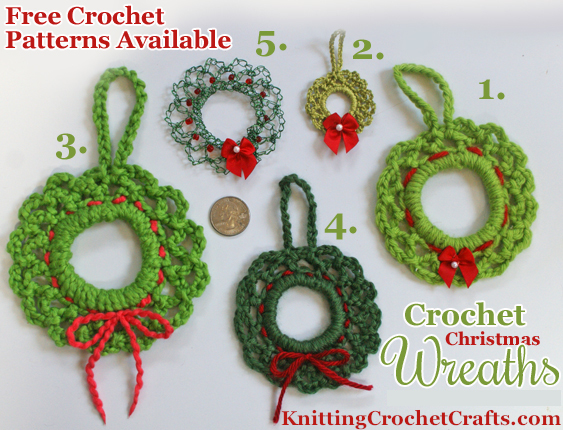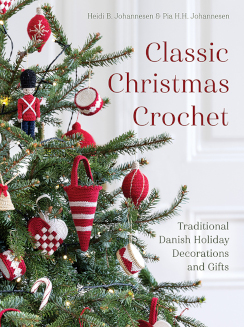
Cindy Writes,
Amy,
The little wreath ornament is adorable. I’m allergic to wool, would another fiber work as well?
My response:
Hi Cindy,
Thanks for the email. I am so glad you like the Christmas wreath ornament, but that’s such a bummer about your wool allergy. 🙁
That is a really great question. There are plenty of other yarns you could use to get good results with this pattern — although there are several good reasons that I recommend using wool yarn. Of course, for anyone like yourself who is suffering from wool allergies, my good reasons are irrelevant, so let’s discuss the alternatives.
Wool is wonderful in this pattern because it’s the perfect weight; it’s beautifully resilient; and it blocks well. While I did not actually block any of my project samples yet, I recommend that you block yours for the best possible results. (I’d block mine, too, except that right now I’m living aboard a boat with 4 cats who won’t leave my projects alone long enough for me to block them.)
Cotton is unlike wool in many ways; it’s not resilient, and it’s also much heavier than wool. Despite those issues, cotton can give acceptable results in this pattern as long as you choose your cotton carefully.
I hadn’t tried crocheting the wreath in other fibers until I got your email. I suspected that this pattern could work well if crocheted in cotton. I decided to raid my stash to see what I could find, and give it a try. Here’s what I found.
Wreath Sample #2: Fine Cotton Embroidery Floss — I used a pretty two-ply mercerized cotton embroidery floss that I have had in my stash for many years. It’s finer than the standard DMC embroidery floss that’s popular with cross-stitchers. I wish I could give you more details about it, but that’s about all I can determine.
I’m guessing that you could get similar results with crochet thread.
I crocheted the wreath using a 7 / 1.65 mm steel crochet hook.
I did not need to use spray starch or other stiffener with this particular version of the wreath I crocheted. However, if you use crochet thread or cotton yarn, it is possible that you might need to starch or stiffen your wreath when you finish it. More on that momentarily.
When crocheted with this floss, the wreath turned out absolutely gorgeous; the only issue is that it’s teeny-tiny. My finished piece measures about 1.75″, not counting the hanging loop.
This could perhaps be a fantastic project for those of you who put up miniature table-top sized Christmas trees; I once had a table-top tree, and if memory serves me correctly, this little wreath would be just the right size for decorating it. If you have children or grandchildren who like to play with miniatures, Barbie dolls or other dolls, it’s also about the right size for Barbie to use in her Christmas décor.
Wreath Sample #3: Sprout Cotton Yarn — This is a gorgeous, textured organic cotton yarn that I happen to have in my stash in a lovely bright green color. I tried crocheting the pattern in this yarn, and found that it is do-able, but not ideal. It’s heavy and somewhat floppy. I don’t happen to have spray starch on hand to try starching it and see if that would help. The jury is out on that; it might not be effective since the piece is rather bulky. Spray starch isn’t a priority item for me to add to my stash at the moment. I’m thinking that if I were going to stiffen it, I’d probably try some sort of glue solution instead. I don’t think I’ll bother, but I want you to be aware that it’s an available option for you if you need it.
Also, I used a size I /9 5.50 mm crochet hook to make this sample; if I had it to do over again, I might try going down to an H to see if that would help. Overall, this version is borderline too big and too heavy for my tastes. I’d suggest sticking to finer cotton yarns or threads if you decide to use cotton.
I think that size 3 cotton crochet thread or sport weight cotton yarn could give good results with this pattern; I would expect the finished wreath to turn out smaller than the original wool sample pictured above, yet it would hopefully not be too small to be useful. I don’t have the appropriate yarn or thread in my stash to test this idea at the moment.
I haven’t worked much with alpaca, but my understanding is that alpaca behaves similarly to wool when crocheting or blocking, so that is another possibility.
You can also achieve satisfactory results with acrylic, although I have some reservations about recommending it.
There are a couple of different “camps” when it comes to blocking acrylic yarns. There are people who swear by steam-blocking acrylic; they say they get great results from it. Then there are the people who think acrylic and heat don’t mix well. I’m in that group.
Acrylic is basically, in essence, a plastic. There are plastics which cannot safely be heated, and there is also much evidence to show that there are dangers associated with the liquid version of acrylic. It seems likely to me that these are also likely to become issues with melted or too-hot acrylic if you accidentally mess up the blocking.
The more I learn about acrylic, the more convinced I become that I really don’t want to continue buying more of it. I do currently have plenty of it in my stash, but in the future I don’t plan to buy more acrylic once it runs out. This is, in part, due to concerns over the health problems its production can cause the workers who handle it during its manufacture.
It’s well-documented that acrylonitrile, the substance which acrylic is mostly made out of, is toxic and has caused many health problems. Now that I’m aware of the problems, I do not want to contribute to them. I have plenty of other choices for fibers that I can craft with. This is not the full extent of my concerns when it comes to acrylic, but that’s a whole different article.
So anyway, all this to say that, in my opinion, acrylic is better left unblocked.
Wreath Project Sample #4: Caron Simply Soft — I tried making a version using Caron’s Simply Soft acrylic yarn, so you can get an idea of how the project looks when crocheted in acrylic yarn. Since Simply Soft isn’t as resilient as wool, and can be a little floppy to work with, I went down to a size G / 4.5 mm crochet hook for this version in hopes of stiffening it up a bit. The result, for me, is a reasonably firm piece that’s acceptable for this particular project. The downside here is that the green I chose is a bit dark, and it could get lost on a Christmas tree; if you choose this particular yarn color for your wreath, I suggest using it as a door hanger or hanging it somewhere other than the tree.
Wreath Project Sample #5: Darice Colored Copper Wire — Even before I received Cindy’s email, I had been wanting to try making a version of this wreath using craft wire. To make this project in wire, I had to entirely re-work, and simplify, the beginning of the pattern, so I wrote a separate page with the new wire crochet version of the wreath.
Overall, I think this is a lovely and interesting alternative to the wool version.
Another version that I haven’t tried, but would be interested to try, is this pattern crocheted in plarn. Maybe I’ll tackle that some other time. For now, at least you have 5 ways to crochet a Christmas wreath — so I’m thinking this question has been sufficiently answered…
For those of you who are adventurous enough to crochet this project in other yarns, threads and fibers, I’d love to have your notes on how it turns out. I’d also love to create a picture gallery showing off everyone’s wreaths — so feel free to send them my way if you are inclined to share pictures of your work.
Get More Christmas Crochet Patterns and Craft Ideas

- Unique DIY Christmas Ornaments to Make
- Main Directory of Christmas Patterns to Knit and Crochet
- Christmas Crafts
- How to Make Christmas Cards
- Big Book of Christmas Crochet Patterns: Make Blankets, DIY Gift Boxes, and More
- Easy Christmas Tree Applique With Free Symbol Crochet Chart
- Christmas Cupcake Potholder
- Check out the BEST book of knitting and crochet (mostly knitting) patterns for making Christmas gifts: It’s Arne & Carlos Favorite Designs. The book features Christmas ornament patterns, Christmas slipper patterns, knitted bird patterns that would be amazing tree ornaments, patterns for making toys and dolls that would be good kiddie gifts for Christmas and much more.
- Find More Holiday Craft Ideas
More Craft Pages You Might Enjoy:

- Yarn for Knitting and Crochet
- Knitting
- Lace Knitting
- Knitting Supplies
- Craft Supplies
- Quilting
- Jewelry Making
- Best Tools for Jewelry Making
- Beadwork
- Sewing
- Sewing Appliques
- Kitchen Crafts
- Paper Crafts
- Fine Art
Find More Craft Project Ideas HERE!
References
If you want more info about the nature and toxicity of acrylic, you can educate yourself about it with these resources:
From the Environmental Protection Agency’s Website: Acrylonitrile Hazard Summary 107-13-1 — IRIS Toxicological Review of Acrylonitrile
From the Agency for Toxic Substances & Disease Registry Toxic Substances Portal: Acrylonitrile
From the Federal Trade Commission’s Website: The rules and regulations under the textile fiber products identification act
J.J. Pizzuto’s Fabric Science
Sixth Edition
Arthur Price
Allen C. Cohen
Fairchild Publications, New York
Copyright 1994
ISBN# 1-56367-004-6
Textiles: Fiber to Fabric
Fifth Edition
Dr. Bernard P. Corbman
McGraw-Hill Book Company
Copyright 1975
ISBN# 0-07-013125-2
Posted By: Amy Solovay
This page was last updated on 10-26-2023.